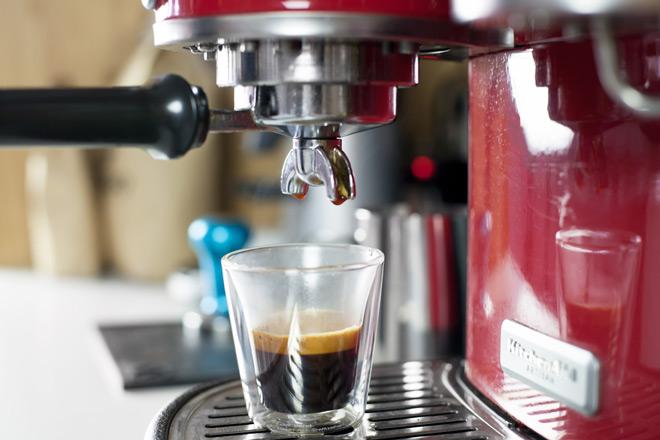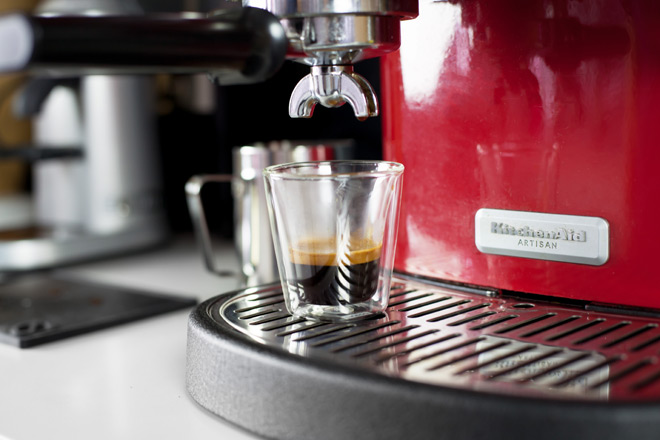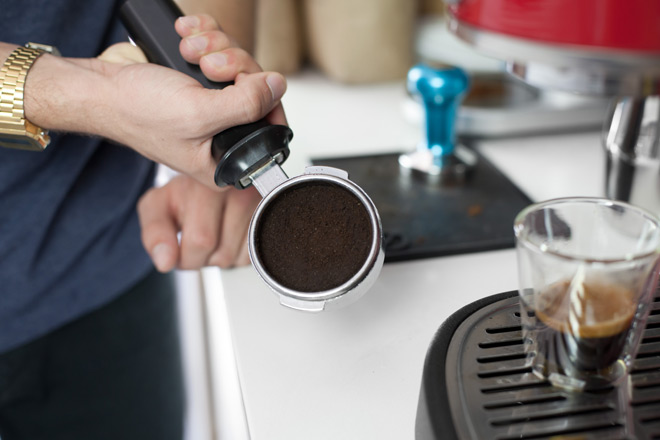How to pull the perfect espresso
Making the perfect cup of coffee is an art form that every self-confessed coffee addict strives to perfect. If that sounds like you, then we’d like to share a few universal tips on achieving espresso excellence with a manual espresso machine like the KitchenAid Artisan Espresso Machine.

While the fundamentals of top quality espresso extraction require some rules to be followed, there is certainly room to experiment in order to fully appreciate the spectrum of flavour that top quality beans offer.

1. Turn on your machine and wait for the boiler to reach optimum temperature. The KitchenAid’s handy pressure dials let us know when it’s good to go. Leave the handle in place (it shouldn’t be full of coffee at this stage) as this will allow the portafilter to warm up along with the rest of the machine – you don’t want your espresso to cool as it passes through it. Warm your cups. You can either pour some boiling water into the cups or use your machine’s cup warmer if it has one.

2. Remove the handle from the machine and give it a wipe with a dry cloth. Grind your coffee, we use the Graef Burr Coffee Bean Grinder. Grind only as much as you plan to use for your current serving. The amount of coffee you use is known as the dose. Know that ground coffee goes stale in a matter of hours.

The texture of your grind should be similar to that of a fine powder. Grind until you have a small mound of coffee that can then be flattened off with your finger. If you like to be precise, 7g of coffee will make a single shot and 14g a double.

3. Tamp the grinds. Hold the tamper in the ball of your hand with your fingers at the base. Your elbow should be at a right angle so that you can apply a decent amount of pressure (a tamping mat comes in handy to protect your countertop). Turn the tamper in the basket so that the surface of the grinds are level. This will allow for an even extraction.

There may be a line inside the basket to indicate the ideal dosage, after tamping, to prepare a shot. Our basket has no indicator but trial and error has revealed that about 4mm from the top is the optimum quantity of coffee.

4. Slide the handle back into place and run your espresso immediately. Remember the shower head of the machine (the part into which the handle fits) is very hot so if the coffee is exposed to it for too long before the espresso is run, the grinds will burn.

The espresso should appear after 4 or 5 seconds. At first there will be a slow drip which will quickly become a solid stream with the consistency of warm honey. If the coffee comes gushing out, your grind is too coarse or you have dosed too little. If the coffee merely drips out, your grind is too fine or you have dosed too much. Experimentation is the order of the day so as to determine what brings out the best flavour in your choice of coffee bean.

A good place to start is finding a grind and dosage that can be extracted for approximately 22 seconds before blonding appears. Blonding is the appearance of pale or white markings on the crema. It occurs when the crema has started to burn so it’s an indication that the extraction has run its course. Too much of it and your espresso will start to taste unnecessarily bitter.

Generally accepted extraction time ranges between 20 and 25 seconds. This will vary according to the origin of the bean, quantity of coffee, pressure from your machine and the texture of the grind. Some coffees can be extracted for up to 30 seconds.
5. Stop the extraction and admire your handiwork. If your beans are fresh you will see a thick crema develop that will settle fairly quickly. The aroma will be out of this world.

Remove the handle and inspect the ‘puck’ of extracted grounds. It should be evenly damp and firm; if they are swimming in a puddle of water you have run your espresso for too long and your brew has been over extracted.

6. Clean up time. A sweet blow will send the puck into the knock box, wipe the basket with a dry cloth and slot it back into place. In our kitchen we have the Dreamfarm Grindenstein Coffee Knock Box.

Whether enjoyed neat, with a jolt of warm water or a lashing of hot milk, the importance of pulling a great tasting espresso is where a great coffee journey can begin.

A side note on cleaning your machine
Remove the handle and brush both the inside of the portafilter and underneath the basket with your espresso brush. Do this on a regular basis. Keep dishwashing liquid as far away from your machine as possible. Oils will build up inside the portafilter over time. Combat this by soaking the metal portafilter (not the plastic handle) in a decalcifying solution.
Head this way to check out the KitchenAid Artisan Espresso Machine and our full range of manual espresso machines.
And if you would like fresh coffee beans delivered to your door, here you go.
